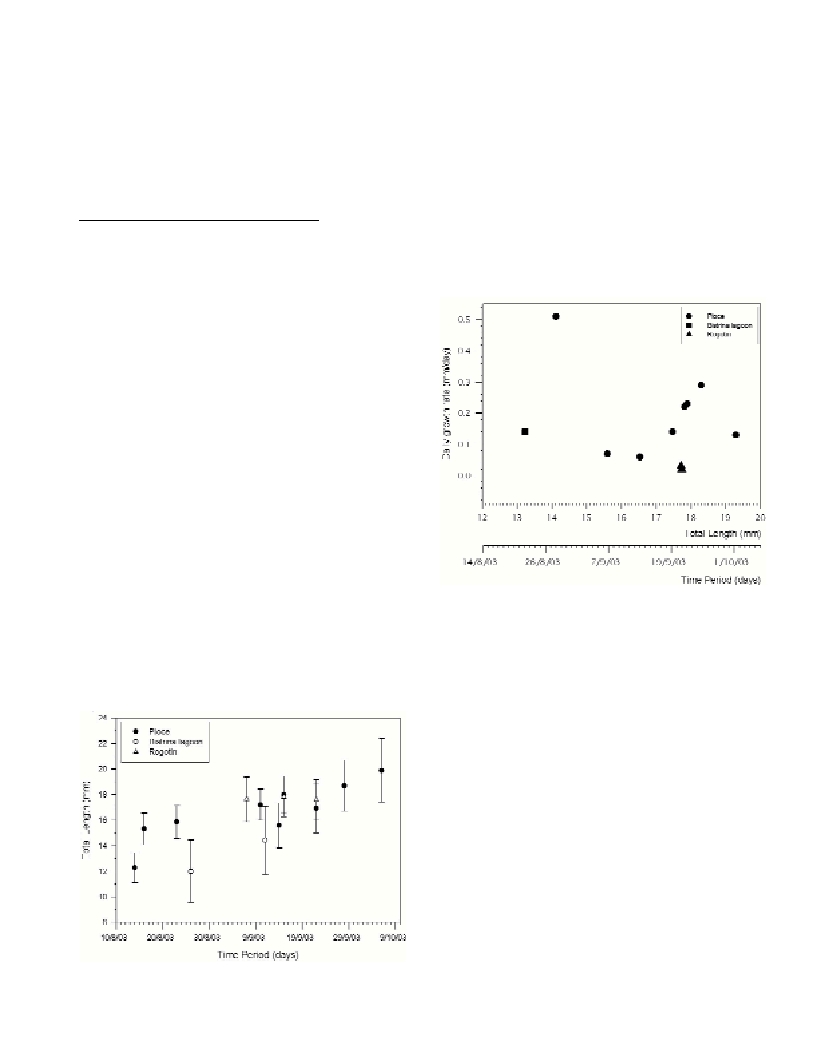PRELIMINARY RESULTS ON EARLY GROWTH AND HABITAT PREFERENCE OF YOUNG WILD GREY
MULLET (MUGIL CEPHALUSLINNAEUS, 1758) ALONG THE EAST ADRIATIC COAST (CROATIA)
Bartulovic V.
1
*, Conides, A.
2
and Glamuzina B.
1
1
Department for Aquaculture, University of Dubrovnik, Croatia - * vlasta@vdu.hr
2
Hellenic Centre for Marine Research, Agios Kosmas, Hellinikon, Athens, Greece
Abstract
In this paper we present results on habitat preference and early growth rates of young wild grey mullet along the south-eastern Adriatic
coast. Grey mullets juveniles showed preference and better growth rates in eutrophic urban areas than in other natural areas and lagoons.
After reaching a total length of 16-17 mm, they migrate to adjacent areas of low salinity.
Keywords: Mugil cephalus, appearance, growth
Rapp. Comm. int. Mer Médit., 37,2004
308
Introduction
Mugilids are commercially important for the Mediterranean [1].
The grey mullet, Mugil cephalus, represents an important commodity
due to good meat quality and high-priced dried roe. However, the
biology and ecology of this species along the Eastern Adriatic coast is
relatively unknown [2]. They usually change habitat several times
during their life so their appearance can be random [3].
Materials and Methods
A total number of 526 young grey mullets were caught during
August-November 2002 using small nets (mesh size 2 mm), at three
stations in Neretva River estuary (the Port of Ploceand Blace village
as marine sites and Rogotin village as a low salinity site) and one
reference station in Bistrina Bay located 30-km from the estuary.
Ploce, Blace and Bistrina are typical coastal marine ecosystems with
salinity ?uctuating between 25-38 psu. Rogotin is a typical estuarine
site located adjacent to a small torrent (Crna Rijeka) with salinity
?uctuating between 2-20 psu. All individuals caught were counted
and measured for total length (TL, mm). Growth rates (in mm/day)
was related to TL as follows [3,4]:
G= a1
–
L-b
Results
TL increased in a linear form. The relationships between TL and
time were positive for Ploceand Bistrina and negative for Rogotin.
However the low abundance of grey mullets in Bistrina and Rogotin
did not allow for applying regression analysis (few data points). For
Ploce, the relationship between TL and time was significant
(r
2
=0.911). Juveniles appeared firstly in the Plocearea early in August
and after almost one month in Bistrina lagoon and finally at Rogotin
and Blace with lower numbers. Juveniles remained in coastal waters
for one month, and started to migrate in freshwater bodies only when
they reached more than 16-17 mm TL. The highest number of
juveniles was observed in Ploce(355 individuals) and lower in
Bistrina (14 individuals), Blace (74 individuals) and Rogotin (83
individuals).
Fig. 1. Temporal distribution of total length of grey mullet juveniles,
Mugil cephalusin Ploce, Bistrina and Rogotin sampling areas.
The relationship between daily growth rates and TL and time (days)
is illustrated in Figure 2. Growth rates were higher (t-test=2.1, df=8,
a=5%) in Plocethan in Rogotin. Inadequate data from the other areas
did not allow statistical comparisons.
Fig. 2. Relationship between daily growth rate, total length and time for
grey mullet, Mugil cephalusjuveniles in the estuary of Neretva River.
Discussion
The grey mullet juveniles showed clear preference to firstly appear
and inhabit urban areas such as Ploceport. The species prefers to
appear first in Ploceport and then Bistrina Bay within the period of 1
month and then distribute laterally to Rogotin and Blace whereas at
Bistrina its appearance is considered as by chance. Their appearance
pattern seems to be size-related and divided in two phases: at first they
spend at least one month in the marine coastal waters until they reach
16 mm TL and afterwards start migrating upstream in the estuary in
areas of lower salinity where they appear when TL > 16 mm.
References
1-FAO, 1987. Mugilidae, pp. 1190-1194. In: Fischer, W., and Schneider,
M.,(eds.), Fiches FAO d’identification des espèces pour les besoins de la
pêche, Méditerranée et mer Noire, Zone de Pêche37, révision 1, volume
II, Vertébrés.
2-Modrušan, Z.,Teskeredžic, E. and Jukic, S.,1987. Biology and ecology
of Mugilidae species on the eastern Adriatic coast (Sibenik Bay). FAO
Fishery Report,394: 159-167.
3-Conides, A., Anastasopoulou, K., Fotis, G., Koussouris, Th., and
Diapoulis A., 1992. Growth of four Mugilidae species in Western Hellas
lagoons. Proceedings of the 27th EMBS, Dublin, Ireland, 7-11 September
1992.
4-Bayley, P.B., 1977. A method of finding the limits of application of the
von Bertalanffy growth model and statistical estimates of the parameters.
J. Fish. Res. Bd Can., 34(8): 1079-1084.

